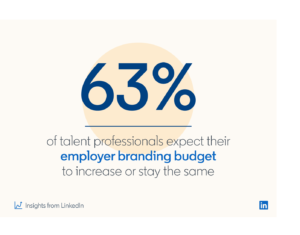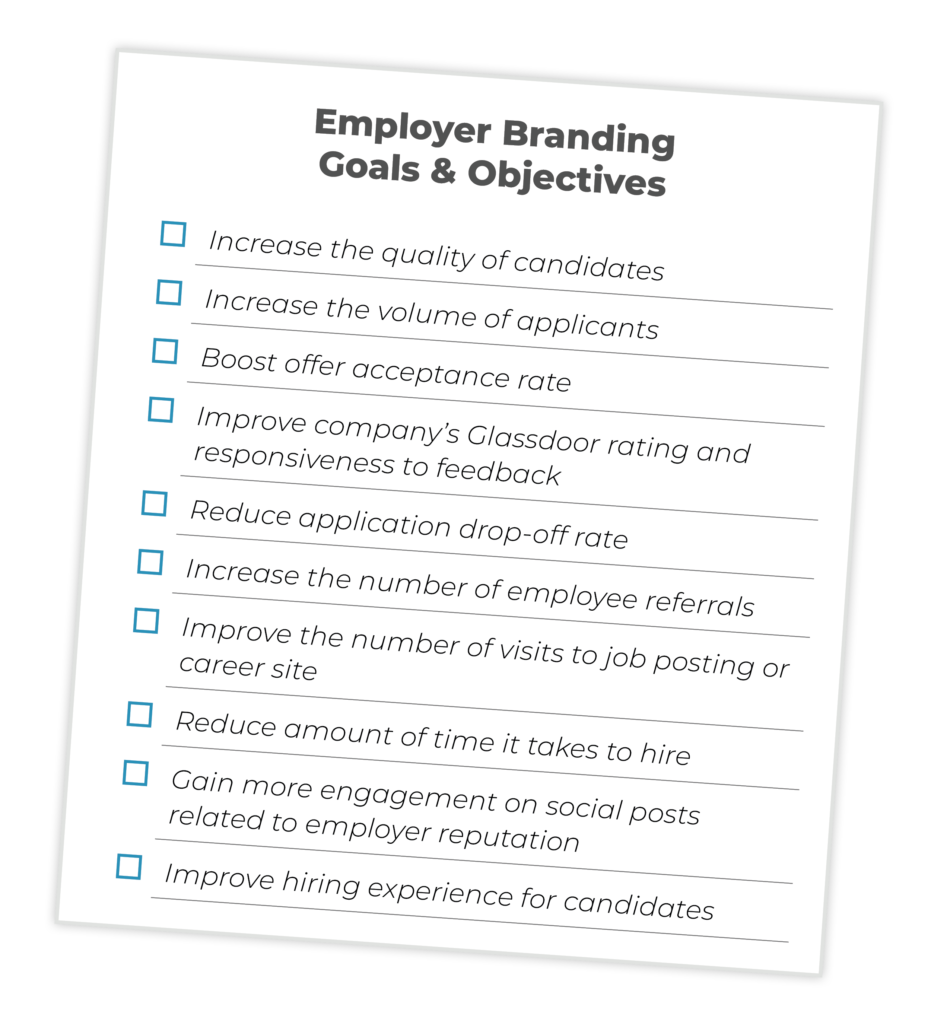Effective employer branding attracts top talent – and assures low attrition rates. With the current labor shortage and millions of workers quitting their jobs because the past year has forced them to reevaluate their lives and careers, it’s never been more critical to address your organisation’s employer branding.
In expectation of a post-COVID hiring frenzy, a LinkedIn survey of talent professionals shows 63% of recruiters expecting their employer branding budget to increase or stay the same.
But first, we need to understand employer branding.
What is employer branding?
Employer brand refers to a company’s reputation as a workplace – hopefully, it’s good. Additionally, employer branding also refers to the practice and art of promoting that brand. Your company’s reputation as an employer and the engagement of your current workers are the backbones of your employer brand, along with your mission, purpose, culture, compensation plans, and anything else that impacts how employees and prospects perceive your employer brand.
Employer branding matters because you can’t hide a bad reputation in a digital world.
But if the employer brand you have isn’t the one you want to promote, it’s never too late to fix it. Focus on becoming the employer brand you want to tell the world about.
Why you should care about your employer brand
Recruiting talent or replacing those who leave is costly. The economic benefits of a strong employer brand can be significant. According to Glassdoor, a strong employer brand can:
- Attract the best talent. 69% of Americans would not take a job with a company that had a bad reputation, even if they were unemployed!
- Improve your retention rate. Most workers, 84%, would consider leaving their current job if offered another with a company that had an excellent reputation.
- Reduce your recruitment costs. If people want to work for you, and your current talent doesn’t want to leave, this reduces cost.
- Differentiate you from your competition. In the current employment market, workers have choices. How will you compete?
- Keep control of your brand. If you don’t define your employer brand, others will do it for you.
Band X CEO Todd Irwin says, “When companies show prospective employees they care about their people and invest in a purpose, they see ROI. Purpose and meaning drive employee engagement and organisations with high engagement have a significant increase in profitability, productivity, retention, and customer engagement.”
How to achieve top employer brand status
- Assess your current employer brand. Start by asking your employees what they think – try a quick survey. It’s essential to know both the good and the bad to understand the status of your employer brand – and to improve it.
Allow your employees to give you honest and confidential feedback, which Engagement Multiplier CEO, Stefan Wissenbach, calls ‘golden nuggets.’ “It doesn’t matter if it’s good or constructive,” says Stefan. “If someone bothers to give you feedback, it means that they care.” That information has value.
And don’t ignore your employer reviews online. Not only should you know what current and former employees are saying, but you need to respond in a genuine and empathetic way so people know you are paying attention.
- Research what job seekers are looking for – today. Times change and so does what it takes to attract top talent to your business.
After 2020, “employee expectations have changed forever,” says Sarah Corboliou, Head of Employee Success at Unito, a Montreal-based workflow management company. To succeed, you need to invest in all of your employees’ well-being and become the company that job hunters are looking for,” says Corboliou. They want remote or hybrid work, flexibility in schedules, mental health benefits and a commitment to diversity and inclusion.
Overwhelmingly, workers who want to leave their current jobs state they want more flexibility, says Jennifer Liu, workplace reporter for CNBC.
- Compare results from steps 1 and 2. If your current employer brand doesn’t align with what the talent you seek is looking for, there is a disconnect.
Your future employees have clarity about what they are looking for in an employer.
In a recent Harvard Business Review article, Tim Minahan, an executive vice president of business strategy for Citrix, wrote, “The last year has forever changed the way employees view and approach work, but one thing holds true: Businesses that want to attract and retain the talent they need to move forward must understand the top priorities of their future workforce.” According to a Citrix study, those things fall into three categories:
-
- Flexible work options – allowing them to prioritise lifestyle,
- Re-imagine how productivity is measured – to be appraised on value instead of volume,
- Work with diverse teams – they value companies that prioritise diversity.
- Set employer branding goals. Now that you’ve established your baseline and understand the current market for talent, you must define your goals for employer branding and the KPIs you will measure to assess success.

Keep the list short and make sure it aligns with overall business goals.
We’ve included a checklist to help you get started, but don’t be constrained by our list. Each business is unique, and so is the talent you need.
There are candidates out there who are not a match for you. “This is an important truth to recognise,” says Bryan Adams, CEO, and founder of Ph.Creative and author of “Give & Get Employer Branding. “Rather than a one-way promotion of strengths and benefits, your employer brand propositions can (and should) be exhilarating to some candidates and a complete turn-off to others. This, paradoxically, is actually a very good thing.”
- Address your problem areas – posthaste. Start addressing problems as quickly as possible. If there are employee comments online which you have never addressed, that may be an excellent place to start. Remember to be empathetic and not defensive. You want people to understand that you appreciate the positive feedback and take any negative comments seriously.
Be the employer brand that values all feedback from your employees.
If some issues are too big to tackle right away, create a strategy to resolve them. Involve your employees in that process and make sure everyone knows that you are working toward solutions.
- Share your employer branding. Start communicating the attributes you want people to know about your employer brand. Focus on:
-
- Your website and career page
- LinkedIn company profile
- Social media
- Online review sites
- Your employees – involve them in telling your story
How to maintain a top employer brand status
Finally, you must plan for ongoing tracking of your employer brand status. Like anything else that matters in business, your employer brand requires key performance indicators (KPIs) which can be tracked and measured.
Start with your employer branding goals as your guidepost and set up a platform for metrics to be tracked. Include quality of reviews online, social media engagement, hiring goals, referrals, and costs for recruiting and hiring. With a strong employer brand established, you should see improvement in all these areas.
Evaluate success frequently and adjust course as talent needs and your business change.



